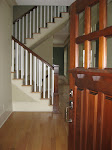Sunday, May 17, 2009
Please see my new blog site!
Monday, May 4, 2009
NAR says sales are up -- Especially in the South!
Pending home sales were up in March, according to the National Association of Realtors.
The pending home sales index rose 3.2 percent to 84.6 from 83.7 in March 2008. The index was also up from February’s index reading of 82.
In the South, the index rose even higher, up 7.7 percent from March 2008 to 93.2. The South's index for March was also up 8.5 percent from February.
It should take a few months for the market to gain momentum, said Lawrence Yun, NAR chief economist, in a statement.
“This increase could be the leading edge of first-time buyers responding to very favorable affordability conditions and an $8,000 tax credit, which increases buying power even more in areas where special programs allow buyers to use it as a downpayment,” he said. “We need several months of sustained growth to demonstrate a recovery in housing, which is necessary for the overall economy to turn around.”
A pending home sales index of 100 is equal to the average level of contract activity during 2001, which was the first year to be examined as well as the first of five consecutive record years for existing-home sales, according to NAR.
NAR also released its housing affordability index figure, which fell from February but is still 30.8 percentage points higher than a year ago. The housing affordability index was 166.7 in March, compared to 174.4 in February.
The March figure was still near a record high for NAR’s housing affordability index, which has been published monthly since 1981.
An index reading of 100 means that a family with the median income has exactly enough income to qualify for a mortgage on a median-priced existing single-family home.
Wednesday, February 25, 2009
Does your dream home improvement project have you scared to death? Don't know where to start? I'd like to help with a little FREE advice.
 Where do I begin? I'd like to re-do the kitchen and add that additional bedroom and office, but I don't think I can afford a contractor. Can I do it myself? Yeah, I think so, but where do I start? I'd like to do some of the work myself, but I can't do the electrical. Do I need a permit? How do I get it? From whom? What will it cost? What do I need to submit? Where do I get plans? How am I going to find subcontractors? How do I keep from getting ripped off? Do I need a bunch of bids? How many? How do I get a loan? Do I need a lawyer? Any halfway sane person thinking about a remodel is asking themselves all these questions and many many more.
Where do I begin? I'd like to re-do the kitchen and add that additional bedroom and office, but I don't think I can afford a contractor. Can I do it myself? Yeah, I think so, but where do I start? I'd like to do some of the work myself, but I can't do the electrical. Do I need a permit? How do I get it? From whom? What will it cost? What do I need to submit? Where do I get plans? How am I going to find subcontractors? How do I keep from getting ripped off? Do I need a bunch of bids? How many? How do I get a loan? Do I need a lawyer? Any halfway sane person thinking about a remodel is asking themselves all these questions and many many more.The idea of undertaking a renovation on your own is overwhelming. Who's gonna do the work? Who does what in what order? And on and on and on.
I think I can help. Times are tough, and people need help getting remodels and renovations done, so I offer you my help -- free for nothing. What!??! I'm Pat Morgan of First Street Builders and want to give you the benefit of my experience. But why is an experienced builder going to help me do my project and not get paid, you ask. That's an excellent question.
There are a number of reasons:
- It keeps me off the streets. You may have heard -- the building business is in the toilet. New projects for a builder/remodeler are few and far between. I'd like to use this time to be helping you with your project vs. sitting at home watching Oprah.
- I'll share my contacts and subcontractors with you. If you choose to use any of them, you're helping me keep them in business through this tough time so they'll be around to help me when the market recovers.
- I believe that I'm more likely to pick up jobs of my own if I'm busy in the industry. Activity begets activity. It keeps me in the mix and positioned for the next opportunity.
- Maybe it's corny, but I like to help people. It's the old karma thing about what goes around, comes around. God didn't put us here to be selfish and self-absorbed.
Friday, February 20, 2009
Built to code means everything is OK, right? Not!
Tuesday, February 3, 2009
Nation's Building News says retrofits essential to energy equation.
Home Remodels, Retrofits Key to Energy Efficiency in Housing
As the nation's home builders embrace green building in growing numbers, industry research indicates that even the most aggressive efficiency goals for new homes won't make a dent in overall energy consumption.
Instead, remodeling and retrofitting the nation's older homes is by far the more efficient solution, industry experts said at a Jan. 21 press conference at the International Builders' Show (IBS) in Las Vegas.
The panelists spoke as NAHB commemorated Green Day, drawing attention to the green education and certification programs offered by the association and the many green products, supplies and materials on display at IBS, the world's largest home building industry show.
The home building industry can combat the potential effects of global climate change by providing additional training to its members and by encouraging home owners to alter some of their habits and make energy-efficient improvements to their homes, the panelists said.
Federal energy officials estimate that Americans consume about 21% of the energy produced each year to operate and maintain their homes — for heating, cooling and electrical appliances, from stoves and refrigerators to televisions, computers and hair dryers. "By just making thoughtful choices, we can reduce that impact," said Ray Tonjes, chair of the NAHB Green Building Subcommittee and a green home builder in Austin, Texas.
"Energy efficiency is absolutely key to our nation's continued security and to our economy,” Tonjes said. “Additionally, we know that building with energy conservation in mind is practical and profitable. My industry has stepped up to the plate to prevent the effects of global warming — but we call it responding to market demand," he said.
The greatest energy savings can be achieved by making changes to existing housing, which is less energy-efficient than today's new homes, Tonjes said. "We obviously can't solve the problem by tearing down all our inefficient housing stock and replacing it with new. We need to make some significant improvements to our existing homes," he said.
Referring to the results of a study his company conducted for the California Homebuilding Foundation last fall, Mike Hodgson, president of the California energy consulting company ConSol Energy, said that 70% of the greenhouse gas emissions related to single-family envelope energy consumption can be attributed to homes built before 1983.
Further, the study demonstrated that spending $10,000 retrofitting a 1960s home could save 8.5 tons of carbon, at a cost of $588 to $1,176 per ton depending on tax credits and incentives. On the other hand, increasing the energy efficiency of a new home by 35% over current state requirements would cost about $5,000 and would reduce emissions by 1.1 tons at a cost of $4,545 per ton.
"Simple arithmetic demonstrates how retrofitting existing homes with energy-efficient features is four to eight times more carbon- and cost-efficient than adding further energy-efficiency requirements to new housing," Hodgson said.
Remodeler Devon Hartman of HartmanBaldwin, a Claremont, Calif design/build firm, said his customers are heeding the call. By adding insulation and sealing and tightening the duct system in one recent large home renovation project, Hartman was able to replace four older heating and air conditioning units totaling 16 tons with a new six-ton system. "We're no longer talking about just putting on sweaters or lowering the thermostat. We're talking about creating energy through efficiency measures," he said.
As more people turn to retrofitting and remodeling, demand will increase for so-called green jobs in which skilled employees either manufacture or install components in the energy-efficient homes of the future.
Fred Humphreys, president and CEO of the Home Builders Institute, the workforce development arm of NAHB, discussed new initiatives to prepare and train these workers, including major revisions of popular industry textbooks and other training materials to reflect today's improved knowledge of building science and green technology.
For more information, e-mail Calli Schmidt at NAHB, or call her at 800-368-5242 x8132.






